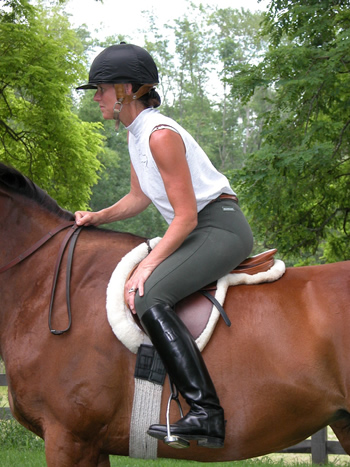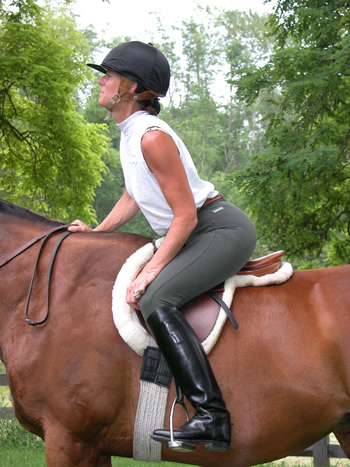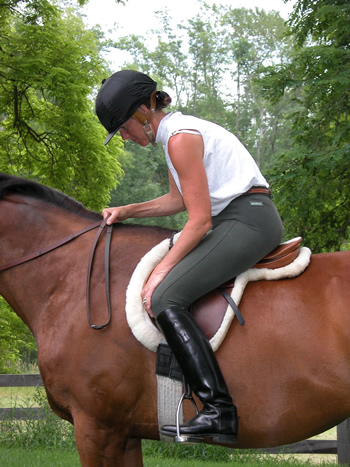
When you ride in a forward position do you feel like you are falling forward? Does your horse speed up or slow down? Does your horse have trouble going up hill? Does he stop at a cross-rail or log on the ground when you attempt to take your weight off his back? The answer may be that you are not folding at your hips when you incline your body forward into your light or jumping seat. Here’s a quick tip to improve your balance and your horse’s performance when you are forward in the saddle.

Whether you ride Western, English, trail or jump having a solid forward position is essential to allowing your horse to move freely under you. A good forward position keeps your weight over the horse’s center of gravity and allows the joint in your legs (hips, knees and ankles) to move freely. If instead you are rounding or arching your back you will be putting the weight onto the horse’s shoulders making it harder for him to balance himself over a log or jump.

Next time you ride notice what happens when you go into a light or slightly inclined forward position. Do your feet slip back? Do you feel unstable? Do you have to grip with your knees or hang onto the reins for balance? Notice if your legs are braced. Can you horse pull you out of the saddle when you go into a light or forward seat?
Notice what is happening with your back. At the walk place one hand on your lower back and feel if it is flat, arched (hollow) or rounded. Move from an upright position to a forward position several times to see if your back changes shape or stays flat. If you are changing your back instead of inclining forward from your hips you will have trouble finding a solid forward position. Here’s a quick tip to improve your position.
On a quiet horse hold your reins in one hand and press that fist into your horse’s neck just above the withers. Place your other hand on your thigh and rest as much of your forearm as possible on your thigh. (Note: this exercise works best when performed off the horse first. Get used to the feeling of a flat back when sitting on a flat level surface like a mounting block or bench, then try this on your horse.) You might notice that you are slightly curved to the side with the forearm on your thigh. This is fine and will not cause a problem later on.
Observe if your back is flat, rounded or arched (hollow). Gently change the shape of your spine from round to slightly arched while keeping your forearm on your thigh. If you feel any pain, stop, make smaller movements and go slower. Remember, you do not want to cause yourself any pain. As you continue to gently change the shape of your spine notice what happens to your back, hips and head. When you find the middle your spine will lengthen, your hips sink back towards the cantle of the saddle and your head lengthens forward/up, away from your seat. In this position slowly sit upright and feel the length of your spine.
Reverse your hand positions and repeat the exercise. After you have found the “long” place in your spine see if you can incline slightly forward keeping the length so that you fold at your hips while holding the reins normally. You don’t need to incline very far forward. The amount you fold forward is dependant on what you are doing. If you are only going over a log on the ground only a slight forward incline is necessary. If you are jumping a 3’ fence you will need to incline forward a bit more but you will also have shortened your stirrups.
Use this Murdoch Minute as a ‘body position self-check’ whenever you are going up hills, over cross rails or simply getting forward off your horse’s back when on the trail at a canter. Experiment with small changes of your back position until you feel your spine lengthen, your head move forward and up and your hips since back. This will allow you to stay in balance when forward in the saddle. And remember – enjoy the ride!
Wendy Murdoch resides in Washington, VA and is an international riding instructor/clinician. She travels worldwide teaching riders of all levels and disciplines how to improve the horse’s performance by improving their body position.
Featured Image: credits to Bit/Lonneke Ruesink




